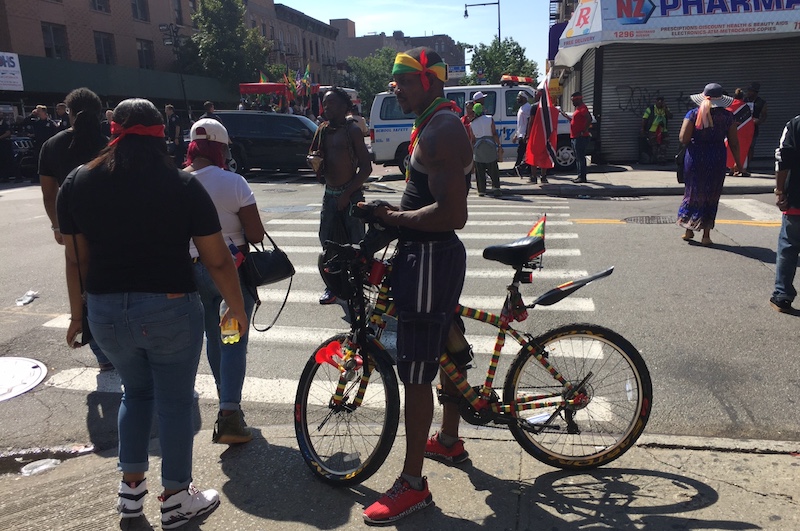Four men were shot and one was killed during last month’s West Indian Day celebrations in Brooklyn. In spite of the violence, the NYPD is calling its reimagined strategy for New York’s largest Caribbean festival a success.
It was, according to Detective Vincent Martinos of the 71st Precinct, the same procedures police use to protect Times Square on New Year’s Eve: Over 4,000 police officers deployed across the two-mile parade route. Thirteen checkpoints equipped with metal detectors and 204 light towers illuminated streets from Flatbush to Nostrand Avenue. Large backpacks and alcohol were prohibited. “We’re dealing with thousands of people, and drugs and alcohol lead to poor decision-making,” Detective Martinos said.
The city’s redoubled efforts come after the death of Carey Gabay, an attorney for Governor Cuomo, who was caught in gang-related crossfire and subsequently died from a gunshot wound to the head on the eve of J’Ouvert 2015. Despite the extra security, 2016 brought more of the same, including the senseless murders of a 17-year-old boy who was an unintended target of a gang-related shooting, and a 22-year-old woman killed for rejecting a man’s advances. In both years, there were also multiple shootings and stabbings that led to non-fatal injuries.
In a press conference on August 21, Mayor de Blasio announced plans to make this year’s J’Ouvert the “safest ever” by performing a security sweep along the route and forcibly holding off the pre-dawn festival, which has historically began at 4 am, until 6 am, in hopes of suppressing violence that may happen in the dark. The city also gave officers “discretion to act in various ways for quality of life enforcement throughout the day.” This included summonses and arrests. According to NYPD Chief of Patrol Terence Monahan, 7 people were arrested, compared to 12 people last year.
But one member of the conference expressed that the annual parade tends to receive a disproportionate amount of attention from the city and from the media. Council Member Jumaane Williams argued J’Ouvert has never been the most violent day in Brooklyn, noting 20 people alone were shot in the borough the weekend of August 19. Williams pleaded with city officials “to not use the memory of victims to push policies” that don’t make the community feel safer, and instead to use momentum from the parade to stay focused on gun violence, “because the weekend after, these communities will still be dealing with violence issues.”
Some community members are also not so enthusiastic about the enhanced security.
“They can attribute their success to whatever they want, but they also killed the parade. Black folks felt like they were under lockdown,” says Imani Henry, Executive Director of Equality for Flatbush (E4F).
According to E4F, these new security measures come in the wake of several reports of racial profiling and police harassment during J’Ouvert 2016. Henry recounted 4 incidents of racial profiling reported directly to E4F this year and says there are more.
“A police occupation already exists in Flatbush, so the potential for profiling and harassment only becomes greater at a parade with black and brown people,” says a cautious Henry. The group is suing the NYPD after it refused to disclose information requested through the Freedom of Information Law. E4F demanded to know the number and types of officers deployed, and other resources implemented in 2016. The NYPD responded with deployment numbers but maintained that any further information must be kept confidential for “public safety purposes.” Those purposes were not specified. Detective Martinos confirmed that the group is in fact entitled to the information and that the NYPD will release it eventually. Henry points out, “it is their duty to be transparent with the community.”
Throughout the parade, E4F tweeted several photos and videos of police sweeps and empty streets. Many complained of floodlights filling neighborhoods nowhere near the route. A white member of E4F reported getting through a checkpoint without being wanded, whereas black people in front of him were thoroughly checked.
Not everyone reported hostile behavior from officers. Nathaly Jackson, 28, said police were respectful and even dancing with revelers. The Boston native said she did not sense any aggression from police.
Andrew Clarke, a vendor working the parade for the first time, said he didn’t have an issue with the heavy police presence, but admitted some of his friends said that the event felt empty. They said “attendance has dwindled and the vibe that is usually present is no longer there.”
Many observers noted sparse crowds at this year’s parade. The West Indian American Day Carnival Association confirmed that attendance was down 50%, from 3 million last year to 1.5 million this year. The reasons behind the lower attendance are harder to know. “Clearly people stayed away,” laments E4F’s Imani Henry. But while he attributes the deserted streets of J’Ouvert to fear of police and the end of DACA looming, Detective Martinos traces the lack of attendance to fear of violence. “People were afraid and didn’t want to come out this year,” he says.
Eighteen year old reveler Cayee James remains conflicted. Though she feels the amount of policing was not necessary, she admits “it’s good to see they cared enough to not have violence” at the parade. “Still,” reflects James, “we get one night to celebrate our West Indies culture but can’t do it the way we want to.”


Leave a Reply